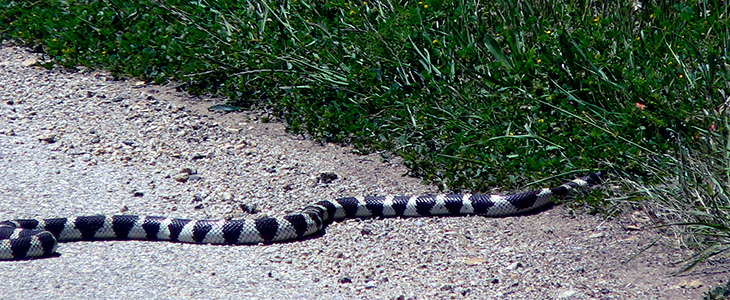Slippery Coating Makes Snake Bellies Slither

(Inside Science) -- Snakes can slither smoothly over almost any surface, from jungle branches to desert sands, without damaging their skin – an ability that has fascinated researchers.
"How can snakes move across very harsh and abrasive environments and still have belly skin that is shiny and smooth?" asked Stanislav Gorb, who studies biomechanics at the University of Kiel in Germany. "Is it the material the scales are made of? The tiny microstructures on them? The molecules they are coated with?"
Gorb and his collaborators have performed research exploring many of these questions. They are presenting it this week at a meeting known as the AVS International Symposium and Exhibition in San Jose, California.
A snake's skin is slippery and smooth all over, but the scales on its belly are even slicker, producing less friction than those on its back. This is odd because at first glance the scales themselves do not appear different. They are essentially all the same size and shape, and both covered in a thin layer of fatty lipids.
So Gorb and his colleagues took a closer look at the scales on the belly of a California king snake, using a scanning electron microscope and a chemical technique called sum frequency generation spectroscopy that bounces lasers off a surface to study in detail the molecules that coat the scales. They found that on the belly scales the lipid molecules were lined up in a highly ordered fashion, in uniform rows and columns perpendicular to the surface of the scale.
In previous work, Gorb and his colleagues had found that the thin lipid layer on the belly was extremely stiff and strong at the surface where it contacts the ground, and got softer as it got closer to the surface of the belly scales. The stiff surface prevents tiny abrasive particles from coming into contact with the skin underneath, while the softer layers below allow the stiff outer layer to flex around the particles without breaking -- like the outer nylon layer of a down-filled winter jacket.
Gorb says that the highly ordered arrangement of the molecules is what creates that tough outer surface on the lipid layer.
The scales on the snake's back, however, have a much different arrangement of molecules.
The lipid layer is much thinner, and does not morph quickly from soft to stiff. The scales themselves are also thicker. This is probably because they have a different job to do, said Gorb. "The back scales are mainly there to prevent reflections, and provide camouflage, rather than help with movement," he said.
While the difference in friction between belly and back is important for the snake, it's not so apparent that a person could feel it just by running their hands over the reptile's body. But Gorb and his colleagues think the snake's smooth coating could be useful in a number of applications like ultra-slippery paints, plastics and coatings.
"It would be interesting to mimic these properties in the next generation of engines, for example," he said. "Anything that is sliding needs to reduce friction."
Like, for instance, robotic snakes. Engineers are designing robots inspired by snakes that can slide and wriggle their way into tight places, such as the rubble of a collapsed building to search for survivors. But it is difficult to get them to slither smoothly.
"Friction is a huge issue, it's one of the most important things to solve" for snake-like robots, said Alon Wolf, director of the biorobotics and biomechanics lab at Technion – Israel Institute of Technology in Haifa.
But it's not just about making the robot slippery, he said. "You want it to be slippery in one direction, but not the other," he said. "Without a grip on the ground, it can't move forward."
Wolf is sure roboticists would love to use a material or coating based on the snake's lipid layer – they are trying everything they can think of to get around the friction issue, including approaches like 3-D-printed skins that can be flexible when sliding forward yet rigid when pushing backwards.
Gorb said that he and his colleagues don't have the engineering or business experience to turn their discovery into a product, but they are open to working with those who do.
"I hope in the next few years we will be able to collaborate with people working on coatings or other applications," he said.

